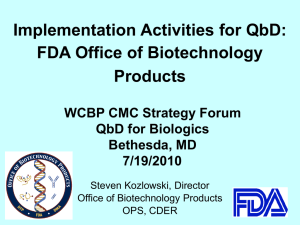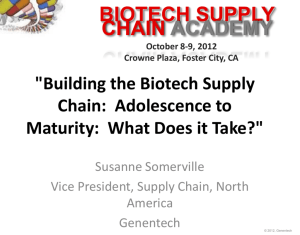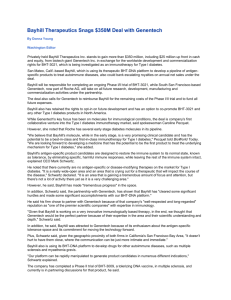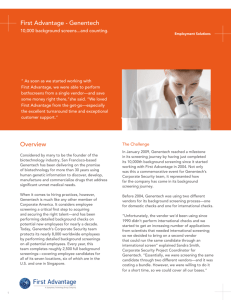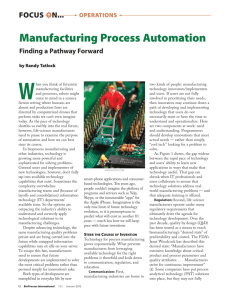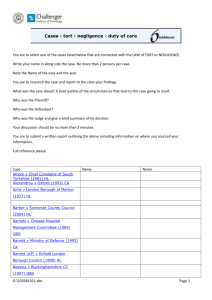Document 11499792
advertisement
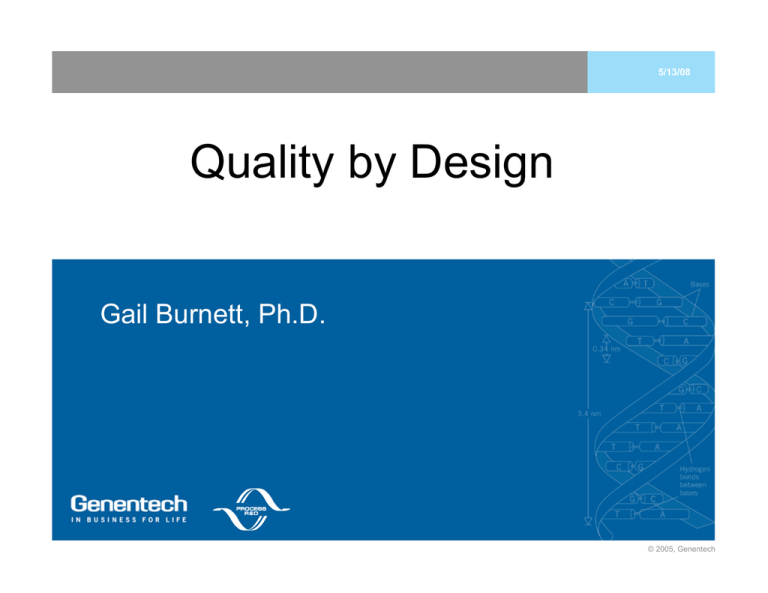
5/13/08 Quality by Design Gail Burnett, Ph.D. © 2005, Genentech Agenda – Quality by Design Slide 2 5/13/08 • Background on ICH Q8, Q9, and Q10 • Quality by Design (QbD) Definitions • QbD Framework The What, Why, and How of QbD © 2005, Genentech The New Paradigm of ICH Q8, Q9, Q10 Slide 3 5/13/08 Q10 Q9 Q8 The new Paradigm Documents available on ICH web site www.ich.org © 2005, Genentech The Role of Process Understanding Slide 4 5/13/08 A Process is well understood when… • all critical sources of variability are identified and explained; • variability is managed by the process; and, • product quality attributes can be accurately and reliably predicted over the design space © 2005, Genentech ICH Q8 Summary Slide 5 5/13/08 ICH Q8 Basic Guideline • Defines what is the ‘minimum’ (Base Line) • The role of Process Understanding • Defines what is a Design Space • Defines Regulatory Flexibility ICH Q8(R1) • Defines what is Quality by Design • The role of a Systematic Approach • Defines Critical Quality Attribute • Examples of Design Space • Defines Control Strategy © 2005, Genentech ICH Q8(R) : Quality by Design Slide 6 5/13/08 Important Elements: Systematic approach Predefined objectives (Target Product Profile) Product and process understanding based on sound science Quality risk management © 2005, Genentech Q8 – General Concepts: What we get in return Slide 7 5/13/08 This scientific understanding facilitates establishment of an expanded design space. In these situations, opportunities exist to develop more flexible regulatory approaches, for example, to facilitate: • risk-based regulatory decisions (reviews and inspections); • manufacturing process improvements, within the approved design space described in the dossier, without further regulatory review; • reduction of post-approval submissions; • real-time quality control, leading to a reduction of end-product release testing. © 2005, Genentech ICH Q9: Quality Risk Management Slide 8 5/13/08 Initiate Quality Risk Management Process Risk Assessment Risk Identification Risk Analysis ICH Q9 Team approach unacceptable Risk Control Risk Reduction Risk Acceptance Risk Management tools Risk Commu nication Risk Evaluation Output / Result of the Quality Risk Management Process Risk Review Review Events © 2005, Genentech ICH Q10 Pharmaceutical Quality Systems Slide 9 5/13/08 Key aspects of the Pharmaceutical Quality System Management Responsibility Product Realization Continual Improvement – Product and Processes – Quality System © 2005, Genentech QbD Definitions Slide 10 5/13/08 Quality: The suitability of either a drug substance or drug product for its intended use. This term includes such attributes as the identity, strength, and purity (from ICH Q6A Specifications: Test Procedures and Acceptance Criteria for New Drug Substances and New Drug Products: Chemical Substances). (ICH Q8) • noun: an essential and distinguishing attribute of something or someone • noun: a degree or grade of excellence or worth • noun: a characteristic property that defines the apparent individual nature of something © 2005, Genentech QbD Definitions Slide 11 5/13/08 Design Space: The multidimensional combination and interaction of input variables (e.g., material attributes) and process parameters that have been demonstrated to provide assurance of quality. Working within the design space is not considered as a change. Movement out of the design space is considered to be a change and would normally initiate a regulatory post approval change process. Design space is proposed by the applicant and is subject to regulatory assessment and approval. (ICH Q8) Critical Quality Attribute (CQA): A physical, chemical, biological or microbiological property or characteristic that should be within an appropriate limit, range, or distribution to ensure the desired product quality. © 2005, Genentech Quality by Design Framework Slide 12 5/13/08 1. Create the Knowledge Space 2. Create the Design Space 3. Link to Quality Systems © 2005, Genentech QbD Framework Slide 13 5/13/08 1. Create the Knowledge Space • Identify the Critical Quality Attributes (CQAs) • Apply QbD by Unit Operation, working backwards from Drug Product • Do a Risk Assessment on each Unit Operation • Conduct Designed Experiments © 2005, Genentech QbD Framework Slide 14 5/13/08 • Identify the Critical Quality Attributes of the new drug product CQA assessment is an iterative process of evaluating the drug product and drug substance attributes throughout development to determine which have potential impact on the safety, efficacy, or potency of the drug. • What do we know from research and pre-clinical development? • Are there any surrogate measures for clinical safety and efficacy? • Do we know what affects clearance or immunogenicity? • Do we know what affects CDC or ADCC? • What do we know from work with molecules of the same class? • Consider how the clinical indication, mechanism of action, route of administration, dosing frequency, patient population, etc. could influence the selection of CQAs © 2005, Genentech CQA Assessment Slide 15 5/13/08 Use CQA assessment to guide development plan – Declare “non-critical” those attributes that are demonstrated through product specific or platform knowledge to not impact safety, efficacy, or potency across a broad range – Focus product characterization and process development activities on attributes that have potential of impact (presumptive or potential CQAs = pCQAs) – Discussion point: Is criticality of an attribute related to control? – A product profile (e.g. chromatogram) can be a quality attribute. – Should product attributes and process impurities be handled the same? © 2005, Genentech QbD Framework Slide 16 5/13/08 Apply QbD by Unit Operation • Work backwards from Drug Product The purpose of each unit operation should guide evaluation of critical attributes (pCQAs) at that step • Define unit operations (process steps) by specific output required ‒ e.g. cell mass vs product titer • The outputs of one unit operation may be the input variables for the next step • Consider the order of unit operations © 2005, Genentech QbD Framework Slide 17 5/13/08 Apply QbD by Unit Operation • Start with a risk assessment (Q9) for each unit operation • Consider and document all parameters that could affect output (pCQAs) • Which process parameters might affect the desired quality attributes at the end of that step? • Which input variables might affect the output quality? • What is the severity and probability of negative impact? © 2005, Genentech QbD Framework Slide 18 5/13/08 Apply QbD by unit operation Example ‒ anion exchange column • Purpose of step ‒ remove host protein Therefore critical attribute (output) studied in experiments should be host protein • What are the input variables that could affect this step? • What process parameters could affect quality? e.g. load, flow rate, pH, conductivity • Design of Experiments (DOE) should evaluate those input variables along with process parameters that have been assessed to have potential to impact host protein clearance. © 2005, Genentech QbD Framework Slide 19 5/13/08 Design of Experiments • How small can we make the experiments? • Understand what design fits what need ‒ screen, uncover interactions, refine 1 + + - + + + - - - + - 2 + - + + + - - - + - + 3 - + + + - - - + - + + • Half-factorial 4 + + + - - - + - + + - • Full factorial 5 + + - - - + - + + - + 6 + - - - + - + + - + + 7 - - - + - + + - + + + 8 - - + - + + - + + + - 9 - + - + + - + + + - - 10 + - + + - + + + - - - 11 - + + - + + + - - - + 12 - - - - - - - - - - - • Plackett-Burman • Etc. • Make sure we are looking at the right outputs • Multiple outputs analyzed separately • Consider where stability is an output © 2005, Genentech QbD Framework Slide 20 5/13/08 Incorporating scale into design space • Should scale be a variable or input factor in DOE? • Can we identify surrogate factors that might vary with scale? Time Contact surface Mixing Heat transfer • Approach will vary for batch or continuous process © 2005, Genentech QbD Framework Slide 21 5/13/08 2. Create the Design Space • Identify the Critical Steps • Identify Critical Process Parameters • Identify Critical Input Variables © 2005, Genentech QbD Framework Slide 22 5/13/08 Definition unclear? • Critical Process Parameter: A process parameter that must be controlled within predetermined criteria to ensure the bulk drug substance meets its specification/quality attributes. A process parameter is critical if the target range (TR) is near the acceptable range (AR) or as determined by a technical expert. Industry not unanimous in regard to importance or relevance of ability to control the parameter. Acceptable Range Acceptable Range © 2005, Genentech QbD Framework Slide 23 5/13/08 Selection of Critical Process Parameters • What if there is no impact on Quality Attributes (e.g. Yield)? • By expert opinion • By risk assessment • By lack of significant effect in robust DOE • By six sigma Critical Parameter • By ratio to CpK Acceptable Range • ??? Non-Critical Parameter Acceptable Range © 2005, Genentech QbD Framework Slide 24 5/13/08 Selection of limits to test in DOE • Do we need to test to failure? • How far beyond control capability is far enough? • Consider all sources of error Critical Parameter Acceptable Range Non-Critical Parameter Acceptable Range © 2005, Genentech QbD Framework Slide 25 5/13/08 3. Link to Quality Systems (Q10) – Documentation of Quality Attributes – Approve Specifications – Documentation of Manufacturing Process (Parameters and Input Variables) – Validation – Change Control – Deviations, Discrepancies, and Investigations © 2005, Genentech Specifications for Quality Attributes Slide 26 5/13/08 • Should all CQAs have specifications? • Must all “Specifications” be demonstrated for each batch on a CoA? • Should some CQAs just be used for comparability? • If process is demonstrated (validated) to achieve the desired level or range of a quality attribute, is a specification needed? • What about removal of process impurities? • What about viral clearance? • Should specifications allow the full acceptable ranges of critical quality attributes? Attributes that we test for process consistency (not CQAs) should have or action / alert limits © 2005, Genentech QbD Framework Slide 27 5/13/08 Link to Quality Systems – Manufacturing Documentation to reflect critical parameters and input variables – Validation should focus on CPPs – Change Control allows change within design space – Deviations, Discrepancies, and Investigations may be reduced by better process knowledge QbD leads to identification of critical quality attributes, process steps, and process parameters, which provides focus to specifications, validation protocol, batch record and controls © 2005, Genentech Quality by Design Submissions Slide 28 5/13/08 • CQAs must be defined before BLA/NDA filing and should include those attributes that have been demonstrated to impact safety, efficacy, or potency of the drug or have high potential to do so (but still unknown) and are not easily controlled. • QbD may be applied to entire process or to selected unit operations • How should we describe Quality Attributes and Design Space in Regulatory Filings? Better understanding of process and product can lead to better science and risk-based regulation of individual products Continue to work with Regulatory Agencies and Industry groups to advance QbD. © 2005, Genentech
